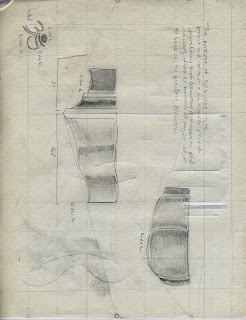


These are some pictures of my second model, this time, to full scale and proportion. Although, the top is not fitted and functional like the final lid will be this model gives a much better feel for how the final box will look complete with decorative ornament on the sides. I am still contemplating the arrangement of the three lines, but I would like them to vary in thickness and wood color. I will most likely use walnut and a lighter wood like cherry or maple. Once again I used hot glue and T-pins to adhere the sides and bottom. Working with this foam was much easier because the pieces were already 1/2" thick and I was able to use an exacto knife to make straight cuts through the coarser foam. I had established my dimensions with the first model an was able to finalize a plan for how much wood I needed to purchase making getting started on the final model much easier.















